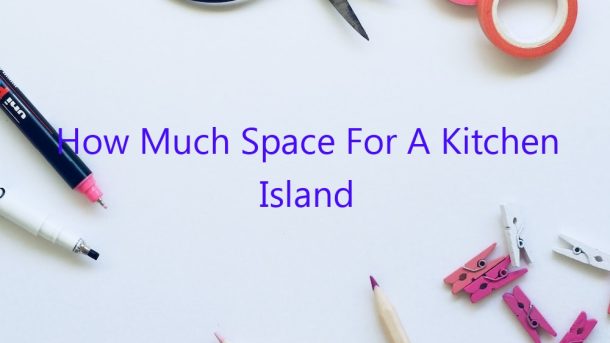When it comes to kitchen islands, the sky’s the limit in terms of size and design. But how much space do you need to allot for an island in your kitchen? And what are the things to consider when choosing an island?
The amount of space you need for an island will depend on the size of your kitchen, how you plan to use the island, and the design of the island. Generally, you’ll want to leave at least 36 inches of space between the island and other cabinets or appliances. This will give you enough room to work comfortably around the island.
If you plan to use the island as a dining table, you’ll need at least 48 inches of space. This will allow you to place chairs around the island.
When choosing an island, consider the features you want. If you need lots of storage, make sure the island has plenty of cabinets and drawers. If you want a workspace, make sure the island has a countertop and space for appliances.
Finally, think about the design of the island. If you want a traditional island with a raised countertop, you’ll need at least 8 feet of space. But if you prefer a more open design, you can choose an island with a lower countertop that doesn’t take up as much space.
So, how much space do you need for a kitchen island? It depends on your needs and preferences. But, in general, you’ll want to leave at least 36 inches of space between the island and other cabinets or appliances, and at least 48 inches of space if you plan to use the island as a dining table.
Contents [hide]
How much room do you need around a kitchen island?
A kitchen island is a great way to add extra counter and storage space to your kitchen. But before you buy one, you need to make sure you have enough room to accommodate it.
How much room do you need around a kitchen island?
That depends on the size of the island. A general rule of thumb is to allow 36 inches of space between the island and any other cabinets or appliances in the kitchen. If the island is going to be used for seating, you’ll need at least 48 inches of space.
If you’re not sure whether your kitchen has enough room for an island, take a tape measure and measure the space. Then, draw a simple sketch of your kitchen and mark the dimensions of the island. That will give you a better idea of whether or not the island will fit.
If your kitchen is already cramped, you may want to consider a smaller island. There are many options available, so you should be able to find one that fits your needs.
If you do have enough room for an island, but you’re not sure what to do with it, here are a few ideas:
– Use the island as an extra counter space. The surface area of an island is usually bigger than a regular counter, so it’s perfect for prepping meals or baking.
– Add storage space to the island. This can include cabinets, drawers, or shelves.
– Use the island as a bar. If you have enough room, you can add stools so that you can use it as a bar. This is a great place to store drinks or snacks.
– Add a cooktop or a sink to the island. If you want to use the island as a cooking station, you can add a cooktop or a sink. This will add extra functionality to the island.
So, do you have enough room for a kitchen island? If so, what will you use it for?
What is the ideal size of a kitchen island?
If you’re remodeling your kitchen, or just looking for some ideas, you may be wondering what the ideal size of a kitchen island is. Kitchen islands can be a great addition to any kitchen, but it’s important to choose the right size for your needs.
First, consider how you plan to use your kitchen island. If you’re going to use it mainly for cooking, you’ll need enough space to spread out your ingredients and tools. If you plan to use it mainly for eating or as a work surface, you’ll need less space.
The general rule of thumb is to allow at least 36 inches between the island and other cabinets or appliances. This will give you enough room to work comfortably. If you have a small kitchen, you may want to consider a smaller island.
Another thing to keep in mind is the height of your ceiling. If your ceiling is low, you may not want an island that’s too tall.
Ultimately, the ideal size of a kitchen island depends on your own needs and preferences. So take some time to think about how you plan to use the island and what size would work best for you.
How much space do you need between island and counter?
When it comes to kitchen design, one of the most important decisions you’ll make is how much space to leave between your island and countertop. But how much space do you actually need?
The answer depends on a few factors, namely the size of your kitchen and the type of island you have. If your kitchen is small, you’ll want to leave at least 36 inches of space between the island and counter to ensure you have enough room to work. If your kitchen is large, you may be able to get away with leaving less space.
If you have a kitchen island with a bar top, you’ll need to leave even more space between the island and counter. A good rule of thumb is to leave at least 48 inches of space between the two. This will give you plenty of room to move around and will also ensure that you don’t hit your head on the island when you’re cooking.
It’s also important to keep in mind that not everyone is the same height, so you may want to leave even more space between the island and counter if you have tall family members or friends who will be using the kitchen.
Ultimately, the best way to determine how much space you need is to measure your kitchen and see what works best. But as a general rule, 36 to 48 inches should be more than enough.
How big does an island need to be to seat 4?
How big does an island need to be to seat 4?
That question is not easily answerable as it depends on the type of island and the specific design. However, a general rule of thumb is that an island should be at least 8 feet long and 4 feet wide to accommodate 4 people.
If you are looking for a more specific answer, it is important to consider the type of seating you would like to use. For example, if you want to use regular chairs, you will need more space than if you plan to use benches or stools.
Another thing to consider is the layout of your kitchen. If you have a small kitchen, you may not have the space for a large island. In that case, you may want to consider a smaller island that can still accommodate 4 people.
Ultimately, the size of your island will depend on your specific needs and preferences. However, 8 feet long and 4 feet wide is a good starting point for most islands.
Are kitchen islands out of style?
Are kitchen islands out of style? That’s a question that’s been debated by homeowners and designers for years. And the answer isn’t always black and white.
There’s no denying that kitchen islands are a popular feature in homes today. They provide extra counter and storage space, and they can act as a focal point in your kitchen. But as with any design trend, they eventually go out of style.
So, are kitchen islands out of style right now?
Well, it really depends on your individual taste and the overall style of your home. If you’re looking to remodel your kitchen and want to stay on trend, you may want to consider opting for a different type of kitchen island.
For instance, a kitchen peninsula may be a better option for your home. They offer the same benefits as kitchen islands, but they tend to be more in style right now.
Of course, if you love your kitchen island and don’t want to get rid of it, there’s no reason to do so. Just be sure to keep in mind that it may not be as popular as it once was.
How far should a kitchen island be from the wall?
The distance between a kitchen island and the wall can affect the function and feel of the kitchen space. Islands can be placed anywhere in the kitchen, but there are some general guidelines to follow for the best results.
When deciding how far the island should be from the wall, consider the amount of traffic that will go through the space. If there is a lot of foot traffic, it is best to leave enough space for people to walk around the island. In general, the island should be at least 36 inches away from the wall.
If the island is going to be used as a dining area, it should be placed closer to the wall. A distance of 24 to 30 inches is generally recommended. This will give diners enough space to pull out their chairs and sit down.
If the island is going to be used as a workspace, it should be placed further away from the wall. A distance of 42 to 48 inches is recommended. This will give you enough space to move around the island.
It is also important to consider the size of the island. If the island is large, it will need more space to breathe. A distance of 48 to 54 inches is recommended in this case.
When measuring the distance between the island and the wall, be sure to include the width of the island.
Does adding a kitchen island add value?
Adding a kitchen island is a popular way to improve the function and appearance of a kitchen. It can provide extra counter space, storage, and seating. But does adding a kitchen island add value to your home?
The answer to that question depends on a number of factors, including the size and features of the island, the kitchen’s layout, and the overall condition of your home. In some cases, a kitchen island can add thousands of dollars to the value of your home, while in other cases, it may have little or no impact.
One of the main benefits of a kitchen island is that it can provide extra counter space. This can be especially helpful in smaller kitchens, where every square inch of counter space is valuable. An island can also provide storage space, which can be helpful in a kitchen that is short on cabinets.
Another benefit of an island is that it can provide seating. This can be helpful for families who like to cook together or for guests who need a place to sit. If you are adding an island for seating, be sure to choose one that is large enough to accommodate everyone.
The size and features of a kitchen island can also impact its value. A simple island with a few countertops and shelves may not add as much value as an island with a cooktop, sink, and storage space. If you are adding an island with lots of features, be sure to budget accordingly.
The layout of your kitchen can also play a role in the value that an island adds. If your kitchen is cramped and in need of more space, an island can be a great way to add it. However, if your kitchen is already spacious, an island may not be necessary.
The overall condition of your home is also important. If your home is in need of some repairs or updates, adding an island may not be the best idea. However, if your home is in good condition, an island can be a great way to improve it.
So, does adding a kitchen island add value to your home? The answer depends on a number of factors, but in most cases, the answer is yes. An island can provide extra counter space, storage space, and seating, which can be helpful in a kitchen that is short on space or in need of some upgrades.




